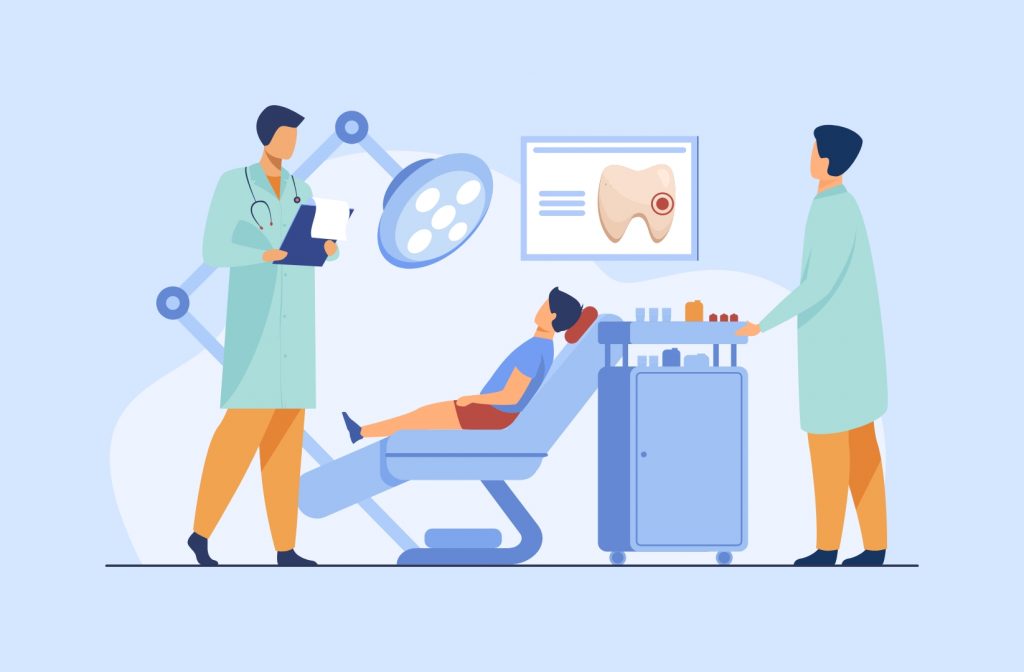The ratio between the number of dentists and the population in the USA is 61:100000. More than one in five (21.3%) said that they had not visited the dentist in the last few years. One of the top reasons adults cite for avoiding the dentist is the inability to find a convenient location or appointment time. Specifically, 19% of adults had not visited the dentist in a few years because they cannot find a convenient location or appointment time. As a dentist or dental practice manager, it is crucial to not just manage existing patients but to account for lost opportunity and plan to improve patient experience, especially with appointment schedule and completion. This will result in an increase in the number of patients visiting dental centers.
Dental centers/groups can begin by leveraging technology to manage the patient referral workflow. Inbound patient referrals having dental issues usually have accompanying ailments such as diabetes or accidental injuries. A seamless experience from appointment scheduling to treatment completion will positively impact patient satisfaction and the volume of inbound patient referrals.
Existing Patient Referral Management Workflow in a Dental Center
Did you know? In a year, 15 billion faxes are sent out with patient referral information in the USA. Practices receive referrals through fax, online forms, direct messaging, email, virtual print, direct walk-ins, and other channels. A typical dental center or dental group is a high inbound referral setup. Dental centers receive large volumes of referrals weekly (ranging from 50 per week to even several hundred per week) depending on the number of patients visiting the center and the number of clinics sending referrals to them. An effective referral management solution will help manage small or big volumes of referrals by reducing manual tasks and using automation and structure where possible.
Dental centers usually have a dedicated team of referral coordinators who receive, accept, and process the referral requests. These referral coordinators manually key in the necessary details into an EMR/ EHR system and create a referral. The time spent by a referral coordinator in a completely manual process can be reduced by using technology. Productivity and efficiency are increased by introducing technology to aid the process. It results in piling up requests that are not yet processed. When the referral coordinator does not have the required information to process the referral, he has to contact the referring provider. This further incurs time and results in a slow referral processing rate. This, in turn, has a negative impact on patient experience. Hence, patient referral leakage also becomes imminent.
Consequences of a Slow Referral Network
- Revenue loss is a direct result of the untimely processing of referrals
- Providers stop referring to the center thereby harming its reputation
- Waiting times and appointment scheduling process affects patients requiring critical and immediate attention
Challenges Faced by a Dental Center
- Multiple Referral Channels: For the specialist/imaging center that receives referrals, face more difficulties than the referring provider. They receive referrals through various channels like fax, email, direct message, website, user-filled forms, etc. Managing and tracking all of it manually is a tedious task. The chances of missing out on a referral are high.
- Appointment Scheduling and Patient No-Show Rates: After receiving the referral, the specialist/imaging center schedules appointments with the patient. In some cases, the patients are not notified clearly about the appointment. When patients do not show up, it is difficult for the specialist/imaging center to track. It results in revenue loss and patient dissatisfaction.
Let us review a typical referral process to elaborate on the challenges faced by the dental centers.
-
Patient Visits the PCP
Andrews met with an accident recently. He met his PCP, Dr. John, immediately as he was experiencing pain in his jaw. After examining him, Dr. John wanted him to consult a dentist. The doctor then initiated the referral.
-
PCP Initiates the Referral
John created a referral in his EMR. He did not have time to do the insurance pre-authorization so he left it to Andrews. He then found a dentist and gave him referral information verbally. Now when he met the specialist, Andrews had to again elaborate on his condition and problems to him. This is time-consuming for the specialist as he wastes time on the same information twice.
-
Specialist Requires More Information
The specialist, Dr. James, is a famous dentist in the locality. After receiving the referral, he schedules an appointment with Andrews. After the appointment, Dr. James wants more information about the patient’s history and diagnostic reports. Now, he has to wait for the PCP, Dr. John, to send him the relevant information.
-
No Tracking System for Referrals
As Dr. James is a famous dentist in the locality, he receives numerous referrals in a day. There is no tracking system for him to know how many referrals he received, how many were processed, in what status each referral is in, etc. So it is difficult for Dr. James to understand the analytics of his specialty.
Overcome your challenges with HealthViewX Patient Referral Management Solution:
With a Referral Management solution like HealthViewX, you can eliminate all your challenges and achieve referral loop closures in an efficient way. Here are some of the key features that will help you transform your referral process:
-
Multi-Channel Referral Consolidation
The HealthViewX solution can capture fax, phone, email, online form referrals or any other referrals in a single interface. It makes it easy to monitor and manage all channels of referrals in a single queue.
-
Patient Coordination Framework
After finding the receiving provider, the referral coordinator refers the patient. When the receiving provider receives the referral, the provider will get notified of the referral. Even the patient will be notified of the referral. The receiving provider can schedule appointments based on the patient’s comfort. This will cut down patient no-show rates.
-
Referral Tracking
HealthViewX gives a clear picture of how a referral has progressed with the help of a timeline view. Every referral has a status that conveys in which stage the referral is in. With the help of a customizable dashboard, the exact number of referrals waiting to be processed can be identified easily.
-
New Referral Channel
HealthViewX Referral Management solution supports a new channel for sending and receiving referrals. This is called the desktop application. Sources like email, website, direct message, fax, etc are not secure and difficult to handle. On the other hand, desktop applications are a secure source for sending and receiving referrals. Also, documents can be attached and sent as a referral.
-
Referral Data Consolidation
It has options for printing the consolidated data about the referrals and the referral history of any patient as a hard copy at any time in pdf/excel.
-
Secure Data Management
HealthViewX Patient Referral Management is HIPAA compliant. It manages all patient-related documents securely.
-
Referral Analytics
Helps in tracking the number of referrals and gives complete information about the referrals processed, missed, scheduled, etc. with the help of a Referral Data-centric Dashboard.
Talk to us to understand how to streamline and automate the end-to-end referral cycle without disturbing your existing EMR setup.








